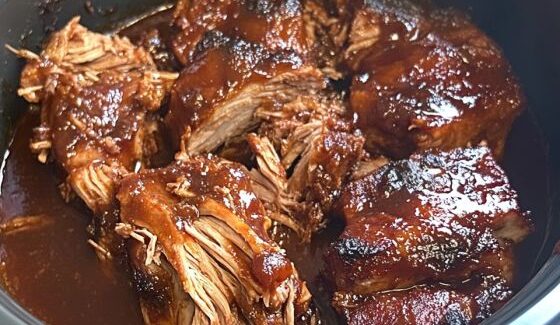
Crab & Shrimp Seafood Bisque — a detailed, step-by-step recipe
Creamy, briny, and luxuriously silky, a good crab and shrimp bisque is both cozy and celebratory. This recipe builds deep flavor by making a shell stock from the shrimp shells, then finishing the soup with cream and tender pieces of shrimp and lump crab. Below you’ll find a full ingredients list, equipment, precise steps (with timings), plus tips, quick shortcuts, and serving ideas.
Yield & timing
- Yields: about 6 servings (approx. 6–7 cups).
- Active prep: ~25–35 minutes.
- Simmering/reducing time: ~45–60 minutes.
- Total time: ~1 hour 15 minutes.
Ingredients
For the shell stock
- Shrimp: 1.5 lb (700 g) raw shrimp, peeled and deveined — reserve the shells.
- Olive oil: 1 tbsp
- Onion: 1 medium (roughly chopped)
- Carrot: 1 medium (roughly chopped)
- Celery: 2 stalks (roughly chopped)
- Garlic: 3 cloves, smashed
- Tomato paste: 2 tbsp
- Dry white wine or dry sherry: ½ cup (or ¼ cup brandy/cognac — optional)
- Water: 8 cups (you’ll strain to about 6 cups finished stock)
- Bay leaf: 1
- Fresh thyme: 2 sprigs (or ½ tsp dried thyme)
- Salt & black pepper: pinch each
For the bisque base & finishing
- Unsalted butter: 3 tbsp
- All-purpose flour: 3 tbsp
- Strained shell stock: 6 cups (from above)
- Heavy cream: 1 to 1¼ cups (240–300 ml) — use 1¼ for richer bisque
- Lump crab meat: 1 lb (450 g), picked free of cartilage (fresh or thawed)
- Peeled shrimp (from the 1.5 lb): the meat, cut into bite-size pieces if large
- Lemon juice: 2 tbsp (fresh)
- Cayenne or smoked paprika: pinch (to taste)
- Salt & white or black pepper: to taste
- Fresh chives and/or parsley, finely chopped — for garnish
- Optional: 1–2 tbsp unsalted butter or a swirl of cream at the end for gloss
Equipment
- Large heavy pot (for stock)
- Fine mesh sieve or chinois + bowl
- Blender or immersion blender (for smoothing the stock)
- Another heavy-bottomed pot for the bisque (or use same pot after straining)
- Whisk, ladle, wooden spoon
Method — step by step
1) Prep (5–10 minutes)
- Peel and devein the shrimp, keeping the meat aside in a bowl (refrigerate). Put all the shells in a separate bowl.
- Roughly chop the onion, carrot and celery (no need to be precise — they’ll be strained out). Smash the garlic.
2) Make the shell stock (35–45 minutes)
- Heat the large pot over medium-high heat. Add 1 tbsp olive oil. Add the shrimp shells and stir. Cook until shells are fragrant and start to color (about 6–8 minutes) — browning the shells unlocks lots of flavor.
- Add the chopped onion, carrot, celery and garlic; sauté 4–5 minutes until softened.
- Stir in 2 tbsp tomato paste and cook 1–2 minutes to remove the raw tomato flavor.
- Add ½ cup wine or ¼ cup brandy. If using brandy you may flambé briefly (optional — be careful) or just let the alcohol cook off for a minute. Scrape any browned bits from the pot.
- Pour in 8 cups water, add the bay leaf and thyme, bring to a gentle boil, then reduce to a simmer. Simmer 30–35 minutes with the lid slightly ajar.
- Remove from heat. Strain the stock through a fine mesh sieve or chinois, pressing solids with the back of a spoon to extract liquid and flavor. Discard solids. You should have roughly 6 cups of flavorful shell stock. (If you want a smoother, silkier base, pulse the solids + liquid briefly in a blender before straining.)
3) Make the roux and build the bisque base (15–20 minutes)
- In a second heavy pot over medium heat, melt 3 tbsp butter. Sprinkle in 3 tbsp flour and whisk to make a blond roux. Cook 2–3 minutes, whisking, until the raw flour smell is gone — do not let it brown deeply.
- Slowly add the 6 cups strained shell stock, a ladle at a time, whisking constantly so the roux dissolves smoothly (no lumps). Once incorporated, bring to a gentle simmer.
- Simmer for 8–12 minutes, stirring occasionally, until the soup thickens slightly and the flavors concentrate. If you prefer a looser bisque, cook less; for thicker, reduce longer.
- Stir in 1 to 1¼ cups heavy cream, taste, and add a pinch of cayenne or smoked paprika, plus salt and pepper to taste. Keep the bisque at a low simmer — do not boil vigorously after adding cream.









No Responses Yet